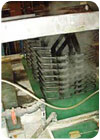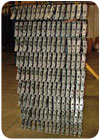
Autocoat utilizes a square transfer dip system, which allows for a variety of parts to be processed.
When e-coat service provider Autocoat needed to cut its reject rate and labor costs as well as improve its efficiency, reconfiguring its racks proved to be profitable.
When 96 percent of your customer base is made up of three main customers, you do all that you can to ensure efficiency, productivity and profit. At Autocoat LLC, an e-coat job shop located in Bryan, Ohio, its three major customers are Alex Products, a seat and interior products manufacturer; A-Stamp Industries, a stamping house; and Dana Corp., whose major commodity is dipstick tubes.
The operation at Autocoat is one that is becoming more popular for e-coaters and finishers alike. The company leases 20,000 ft2 inside one of its customer's buildings. In this case, that customer is A-Stamp.
Autocoat uses an indexing square slide transfer (SST) system that was designed and built by Therma-Tron-X (TTX), Sturgeon Bay, Wis. It is a 15-tank operation, with the first 11 consisting of pretreatment. There are two alkaline, a rinse, an alkaline, two more rinse, a zinc conditioner, a zinc phosphate and three more rinses. The e-coat paint tank and three post-paint tanks - a spray rinse, permeate rinse and then an RO (reverse osmosis) rinse - complete the coating cycle. Load bars then travel up on an elevator to the zone-heated convection oven that sits above the tanks, where they index through the preheating, cure and cool-down zones of the oven at the same rate throughout the entire cycle.
Greg Cramer, plant manager at Autocoat, says the shop paints 18 load bars an hour.
Maximizing the load bar density while reducing and eliminating rejects is one key to an e-coater's success. Cramer says that for many of Autocoat's jobs, generic racks work fine, but when the company was having difficulty hanging stabilizer rods and getting the line density required without fallout, Cramer knew they had to call in some help. After reading up on several racking companies in trade magazines and online as well as by word-of-mouth, Cramer says Autocoat ultimately worked with Magic Rack/Production Plus Corp. to find a solution for racking these stabilizer bars.
"It is a coined, trimmed and pierced tube that had a drainage issue," Cramer explains. "Our line density was somewhere around 200 pieces. When we enlisted Magic Rack, we looked to increase that significantly, and our goal was to get 600 pieces on line. We wanted to triple it."
Autocoat looks to solve racking problems on its own. And because Cramer has a fabricator background and is mechanical, many of the racks in use at Autocoat are Cramer's designs (see sidebar). "But in this particular case," he says, "we needed something with a spring form, not a mechanical or large laser cut area. So we selected Magic Rack for their specific talents." Turns out in that case, Autocoat and Magic Rack accomplished exactly what they set out to do and got 600 parts on a load bar. Although the design is proprietary, they were able to hang the rods in such a way that all the liquid can drain out. "Before enlisting Magic Rack, we had a lot of fallout because of trapped water or fluid, and carry over from tank to tank was terrible, too," Cramer says. "So we needed to keep the part vertical so that we had good drainage, which was the fundamental problem, and they solved that for us with their racking."

Maximizing the load bar density while reducing and eliminating rejects is one key to an e-coater's success.
Prior to contacting the custom rack manufacturer about the support brackets, Autocoat was getting about 300 parts on a load bar and had a 40 percent reject rate. "We went from there to having zero rejects and painting 500 parts at a time." And in this instance, the job was even more efficient because their customer has another operation in house. "We were able to take the rack directly over to them in house, which reduced our costs because we did not have to touch it again," Cramer says.
On this particular job, there were significant savings all around. Autocoat experienced 20 percent labor cost reduction, increased productivity by 46 percent, and first-time quality went from 60 percent to 100 percent. Overall on this job, the shop increased productivity by 72 percent while reducing labor costs by 20 percent.
Autocoat is QS9000 certified and working on its TS16949 certification.
To contact Autocoat, call 419-636-3830.
To contact Autocoat, call 419-636-3830. For information on Magic Rack/Production Plus Corp., call 614-492-8811 or visit www.Magic Rack.com. For information on TTX, call 920-743-6568 or visit www.therma-tron-x.com.
For information on reprints of this article,
contact Jill DeVries at devriesj@bnpmedia.com.

Report Abusive Comment